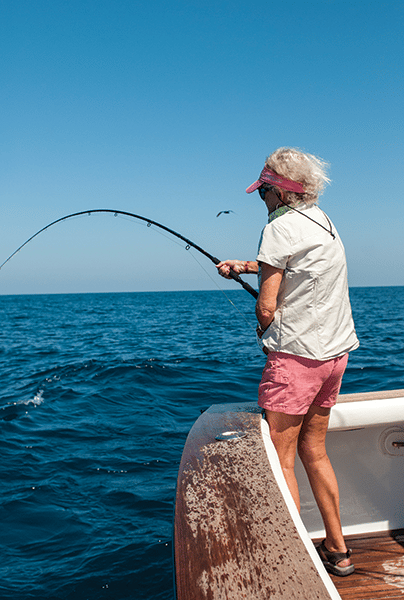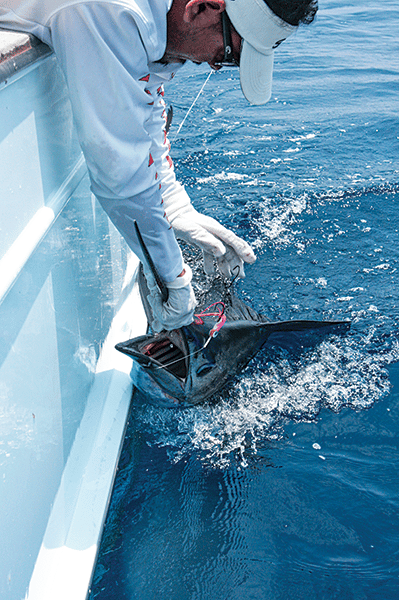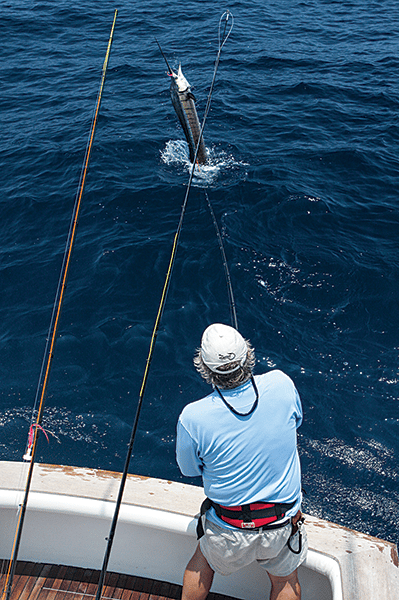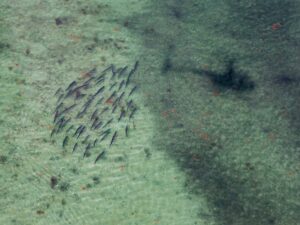Most charter skippers end up specializing in one aspect of saltwater fishing or another during their careers, becoming known along the way as the go-to guy or gal in a particular area. Capt. Chris Sheeder, who runs the 40-foot Gamefisherman charter boat Rum Line out of Casa Vieja Lodge in Guatemala, is one of them. If you want to learn how to catch Pacific sailfish on a fly rod, Sheeder’s your guy.
My wife, Poppy, wanted to learn that very skill, so this past December we flew to Guatemala to meet Sheeder and his crew, because we knew they had both the experience and the necessary numbers of fish to make our efforts successful. It always helps to have lots of shots when trying something new. Sheeder fishes a pretty standard one-sided trolling pattern with hookless teaser baits pulled from the right outrigger and flat-line positions (to the left as you face aft) for right-handed fly-casters. As his crew deployed the teasers, Poppy took up a position in the right rear corner of the cockpit, fly rod at the ready, as Sheeder explained the game plan to us.
Get Close
He likes to tease the fish close to the transom, and have the angler cast slightly to the side of and behind the fish. “We increased our hookup percentages by cutting down casting distance and teasing fish closer to the boat than where the fly will hit the water to get that going-away bite,” Sheeder said. “The prettiest sight in all of sport fishing is overteasing a billfish, so he keeps looking for the pulled teaser under the boat and around the props, and finally, after what seems an eternity, he sees the fly and blasts out to bite it.” On our first day fishing out of Puerto Quetzal, it didn’t take long to experience that firsthand.
A sail soon appeared in the spread, and Sheeder calmly shouted out orders to those of us working the cockpit. His team has this drill down pat, and the mates worked the teasers flawlessly. When the fish came into the desired range, Sheeder hollered, “Cast!” as he simultaneously shifted the boat to neutral and the mate yanked the teaser from the water. Poppy executed a large roll cast, and for a minute, it looked like the fish had disappeared. But just as Sheeder had prophesied, it suddenly charged from beneath the boat and engulfed the fly.
Sheeder had earlier instructed us to watch which way the fish turned after the bite, and then strike in the opposite direction. “You have to make a quick decision during the bite,” he said, “because if you strike in the same direction the fish turns, you’ll pull the fly right out of its mouth.” Poppy heeded her teacher’s words and struck left after the fish headed right, sinking the hook in the fish’s jaw: The fight was on.
Sweet Release
The sailfish put on an impressive aerial display, but the 14-weight fly rod soon did its job, and Sheeder’s mate, Zonder, tagged the fish before releasing it. The whole thing happened so quickly that it took a minute to sink in that Poppy had just released her first sailfish on a fly rod, an epic event. We reset the baits and set off in search of another bite amid major high-five activity.
“I started taking fly-fishing for billfish seriously back in 2001,” Sheeder said. “I found that stepping back and catching fish this way is really cool. Teasing sailfish is a strategic process, but when a blue marlin shows up, that procedure had better be perfect. Sailfish are usually pretty forgiving, but if you let a blue whack a teaser too many times, he’ll lose that aggression needed to trick him into biting the fly.”
Be Ready
Relentless vigilance raises your odds of success at this game. You must stand ready to cast in short order because sometimes fish come in hot, and you can’t afford to lose precious seconds fumbling around for the fly rod and line. When you spot the fish, never take your eyes off it, because you must know exactly where it is to make an optimal cast. When it works right, it’s the easiest thing ever. Simply make a roll cast to where you predict it will turn when the mate yanks the teaser from the water, and the bite usually happens automatically.
But as with most forms of fishing, sailfish sometimes get uncooperative, and that’s when you must be as precise as possible to get the bite and successfully hook the fish. When the fish bite on your initial cast, you only have to remember which way to strike. But when the fish drop back or simply sink beneath the surface after refusing the fly, what then?
Noncooperation
We encountered a few stubborn fish on our trip, and the mates would tease them back to the boat again and again by casting hookless ballyhoo teasers in the direction they swam off and coaxing them toward the transom. In that situation, you often must make more technical and difficult casts in an effort to entice a strike. And when it’s easy, one pop of the fly on the surface often does the trick. When they get lockjaw, you must sometimes strip the fly repeatedly to find a cadence they want to bite.
The sailfish-on-fly business has become Sheeder’s hallmark and his stock in trade, and he recently released his 5,000th fly-caught billfish, quite a remarkable career feat. If fly-fishing for sails sounds like something you’d like to try, there’s no one better to teach you, and no place better to give it a shot than the productive grounds off Guatemala. Once you’ve done it, you’ll be hooked on it like the rest of us.

















